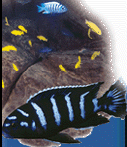

AFRI»KI CIKLIDI
Dimidiochromis |
Dimidiochromis Trewawas 1989Dimidiochromis strigatus Regan 1922 Original Description:
From the latin dimidiatus, divided in two, the generic name of this group of piscivorus Lake Malawi endemic haplochromines clearly express one on the main diagnostic features; a mid-lateral band dividing the flanks of the fish. Ethelwyn Trewawas (Eccles & Trewawas 1989) described this genus for a group of four species of predatory haplochromines endemic of Lake Malawi and previosuly assigned to the genus Haplochromis; Dimidiochromis compressiceps Boulenger 1908, Dimidiochromis dimidiatus GŁnther 1864, Dimidiochromis kiwinge Trewawas 1935 and Dimidiochromis strigatus Regan 1922. Type species was designated Haplochormis strigatus Regan 1922. Diagnostic traits include a "deep lower jaw, strongly developed chin and well-spaced caniniform teeth in fish over 60 mm SL", among other features. Lower jaw is always longer than the upper one. Distributed in shallow water habitats of less than 10 meters depth all around Lake Malawi, Dimidiochromis are plankton feeders when small, turning into shallow water predators when they reach a size of 4 centimeters, when they feed mostly on fish but as well upon invertebrates. Dimidiochromis compressiceps does hide among Vallisneria or cane beds waiting for its fish preys. It is known to adopt a headstanding position while waiting for its food, it inhabits shallow water where other "utaka" haplochromines usually release their young, maximum size is reported as 24 cm. (Konings 1996). Aquarium observations on Dimidiochromis strigatus (Baasch 1992) suggest that is as well an ambush pedrator, it is reported (Trewawas 1989) that it also inhabits shallow water among Vallisneria or Potamogeton schweinfurthii beds. On the other hand Dimidiochromis kiwinge ("binga" in chiChewa language) is a powerful scavenger which reaches 30 cm. in length, it gregariously hunts in shallow water making extensive digging and dashing for any edible animal that shows its way (Konings 1996). Dimidiochromis are nest building moouthbrooder cichlids which build castle and crater nests in the sand near the cover of vegetation or rocks, eggs are fertilized inside the female's mouth, and maNy fry are known to be released, over hundred in D. compressiceps (Konings 1996) and over 200 in D. strigatus (Baasch 1992).
References
|